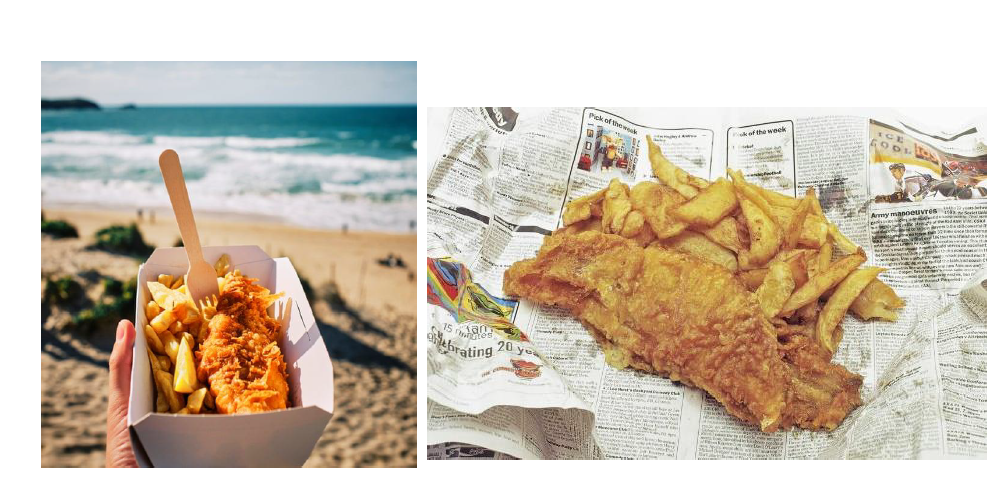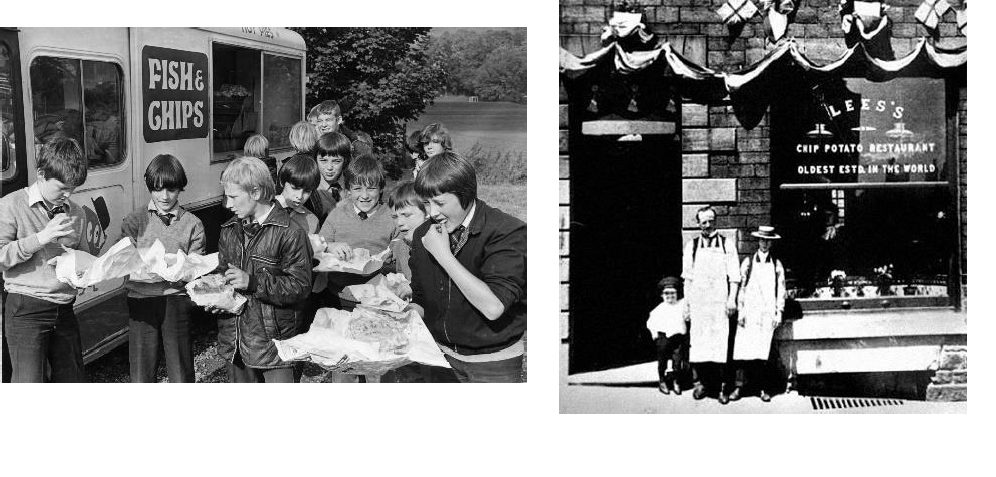 |
(2023.09.14) |
日本語、フランス語版と英語版があります。 Ce poste est publié en japonais, français et anglais. Version française au mileu de page (la deuxième). This post is available in Japanese, French and English. Scroll to the bottom for the English version.
......
イギリスならではのフィッシュ・アンド・チップス
イギリスと言えば、最も有名な料理はフィッシュ・アンド・チップスではないでしょうか。イギリスに旅行に行ったら、一度は、フィッシュ・アンド・チップスを食べたのではないでしょうか!フィッシュ・アンド・チップスはイギリスの国民食の一つです。日本でも、ブリティッシュ・パブに行くと、フィッシュ・アンド・チップスを食べることができます。
今回の記事では、フィッシュ・アンド・チップスの歴史を説明したいと思います。まず、フィッシュ・アンド・チップスとはどんな料理でしょうか?英語で「フィッシュ」の意味は魚です。「チップス」の意味は国によって違います!イギリスで「チップス」と言えば、フライドポテトです。アメリカでは、「フレンチフライズ」と呼ばれているものです。(※イギリス英語とアメリカ英語の違いを学びたい場合には、前回の記事をぜひご覧ください!)
フィッシュ・アンド・チップスの「フィッシュ」はタラのような白身魚が使われていて、天ぷらと似ています。伝統的なイギリスの「チップス」と、日本のフライドポテトは少し違いがあります。イギリスの、「チップス」はもっと分厚くて、ふわふわです。イギリスにも、アメリカのチェーン店であるケンタッキーやマクドナルドに、日本と同じようなフライドポテトがありますが、フィッシュ・アンド・チップスを注文すると、イギリススタイルのチップスが出てきます。
イギリスでも、日本と同じようにフライドポテトを食べる時に人気のソースは、ケチャップです。でも、象徴的なフィッシュ・アンド・チップスのソースはモルトビネガー(大麦麦芽酢)と塩です。そのため、イギリスで人気のポテトチップスはソルト・アンド・ビネガー味です。スコットランドでは、フィッシュ・アンド・チップスは「ブラウン・ソース」とモルトビネガーを混ぜたソースで食べます。「ブラウン」の意味は茶色で、このソースは日本のお好み焼きソースの味に似ています。
フィッシュ・アンド・チップスの起源は定かではありませんが、移民に関係しています!日本では鎖国時代が長く続きましたが、イギリスは移民の国です。異なる国の食文化の混合のおかげで、フィッシュ・アンド・チップスが生まれました。フィッシュ・アンド・チップスの起源の前にジャガイモについてお話しします。私が驚いたことは、元々ジャガイモはイギリスで植えられた野菜ではありませんでした。実は16世紀に南米に渡ったヨーロッパの人が初めてジャガイモを見つけ持ち帰りました。アメリカで呼ばれている「フレンチフライズ」の意味は「フランスのフライドポテト」です。では、「チップス」はフランスから来たのでしょうか?そうとも言えません!実は、フランスのみならず、ベルギーもチップスの発祥地ではないかと言われています。どちらの国が本当の発祥地かは分かっていません!ベルギー人、またはフランス人が、イギリスに移住した時にフライドポテトの食文化を持ってきたのでしょう。「チップス」は17世紀中ごろに人気となりました。フィッシュ・アンド・チップスのフライド・フィッシュ(揚げた魚)は、16世紀にイギリスに来たようです。衣をつけて揚げるフライド・フィッシュはユダヤ教信者の習慣でしたが、16世紀にポルトガルやスペインで迫害され、イギリスへ避難した際にこの食文化を持ってきました。
このように、フライドポテト(チップス)やフライド・フィッシュがそれぞれイギリスで食べられるようになりましたが、イギリスならではの組み合わせであるフィッシュ・アンド・チップスはどう始まったでしょうか?残念ながら、それは分かっていません!歴史家によると、ロンドンかイングランドの北にあるランカシャー州がフィッシュ・アンド・チップスの発祥地の可能性があると言われています。ロンドンでは、1860年ごろ、ロンドン東部でジョセフ・マリンという東ヨーロッパからのユダヤ系移民がフィッシュ・アンド・チップス店を開店しました。ランカシャー州については、1863年ごろにジョン・リーズという実業家がマーケットの屋台でフィッシュ・アンド・チップスを売り始めました。産業革命時代でしたので、町に労働者が多く、フィッシュ・アンド・チップスは安く、栄養がある食事でしたので、すぐに大人気となりました。そして、イギリス中に、フィッシュ・アンド・チップスの店ができました。
ロンドンもランカシャー州の発祥地も、海岸に近くないのですが、本来、フィッシュ・アンド・チップスのイメージは海岸で食べられる食事です。海岸で食べられるフィッシュ・アンド・チップスは鮮魚であるイメージがあります。多くのイギリス人は、夏に海岸に行って、フィッシュ・アンド・チップスを食べています。テイクアウトをして、海を見ながら食べることが人気です。
フィッシュ・アンド・チップスの多くのお店は小さく席が少ないので、フィッシュ・アンド・チップスを持ち帰ることが普通です。イギリスでは、日本と違い、外に座って、食べることは失礼なことではありません。イギリスではストリートフードのほうが人気です。家族と一緒に食べるために、家へ持って帰ることも普通です。フィッシュ・アンド・チップスの店だけではなく、多くのパブ、イギリス食レストランでもフィッシュ・アンド・チップスを食べられます。
フィッシュ・アンド・チップスの店は、1910年に25,000軒あり、1930年代には35,000軒まで増えました。第二次世界大戦中、お肉、牛乳や砂糖、多くの食料品が配給制となりましたが、フィッシュ・アンド・チップスは配給されなかった数少ない食料品の一つでした。イギリス政府は、フィッシュ・アンド・チップスを配給しないことが国民の士気を高めると考えていました!イギリス人がどれほどフィッシュ・アンド・チップスを愛しているか分かるエピソードですね!イギリス人はフィッシュ・アンド・チップスを愛着の意味を込めて「Chippy(チッピー」」と呼んでいます。
イギリスは人種のるつぼ、まさに多文化共生社会で、国民食としてのフィッシュ・アンド・チップスはそういう歴史を代表していると思います。しかし、現在、イギリスにあるフィッシュ・アンド・チップスのお店は、約10,500軒です。20世紀初頭と比べて、大きく減少していますね。最近は、ケバブ、チキンといったファストフードが人気になって、スマホアプリのおかげで何でもお持ち帰りできます。アメリカのチェーン店も増えています。それ以外にも、燃料高騰が漁業に打撃を与え、フィッシュ・アンド・チップスの値段が上がったことも原因となり、倒産するフィッシュ・アンド・チップスのお店が増加しています。フィッシュ・アンド・チップスの歴史は不確かですが、残念ながら未来も不確かになりました。皆さん、イギリスのパブでフィッシュ・アンド・チップスを注文して、「チッピー」の伝統を大事にしましょう!
イギリス人は1世紀以上にわたりフィッシュ・アンド・チップスを愛してきましたので、これからも国民食であることは変わらないと思います。フィッシュ・アンド・チップスを食べることはイギリスならでは習慣なので、イギリスに行く機会があったら是非「チッピー」を食べてみてください!

....
...
Le plat national du Royaume-Uni, le fish and chips
Le fish and chips est peut-être le plus célèbre plat britannique au monde, et est sans aucun doute l'un des mets nationaux. En tant que britannique habitant au Japon, lorsque je mentionne d'où je viens, les japonais réagissent souvent en mentionnant le fish and chips. Du coup, le fish and chips est bel et bien un symbole du Royaume-Uni, et beaucoup de touristes qui s'y rendent en font la dégustation comme activité touristique à part entière. Même au Japon, si vous allez dans un pub de style britannique, vous trouverez probablement du fish and chips au menu.
Aujourd'hui, je vais écrire au sujet de l'origine du fish and chips : mais tout d'abord, qu'est-ce que le fish and chips ?
« Fish », en français poisson, et « chips », qu'on appelle frites. Une différence entre l'anglais britannique et l'anglais américain est qu'aux Etats-Unis (et beaucoup d'autres pays anglophones), on appelle les frites « fries », tandis qu'au Royaume-Uni on dit « chips ». Pour compliquer encore les choses, les chips que les français connaissent sont aussi appelées chips aux Etats-Unis, mais au Royaume-Uni sont désignées par « crisps ». Donc, dans ce post, lorsque je dis « chips », je parle de du terme britannique qui désigne... les frites !
Ce qui est intéressant, c'est qu'on utilise quand même parfois le mot « fries » au Royaume-Uni, mais pour faire référence aux frites qui ne sont pas normalement britanniques : les frites fines, comme dans les moules-frites ou les frites des fast-foods de chaînes américaines. On fait la différence car les « chips » traditionnelles du Royaume-Uni sont plus épaisses et non croustillantes. Bien que les « fries » existent donc au Royaume-Uni, si on commande un fish and chips, on nous servira les épaisses « chips ».
Dans le fish and chips, le poisson est également frit. On utilise toujours un poisson blanc, en particulier de la morue ou de l'aiglefin. Le poisson est enrobé de pâte avant d'être frit. La pâte est un mélange de farine, d'œufs et de lait, ainsi que d'assaisonnements au choix : la bière fait partie des possibilités.
Le ketchup est peut-être bien le condiment le plus populaire du monde à manger avec les frites. Il est populaire au Royaume-Uni également, au même titre que la mayonnaise, la sauce curry ou le jus de viande. Cependant, la façon traditionnelle de manger le fish and chips est avec du sel et du vinaigre. Grâce à l'épaisseur des frites britanniques, le vinaigre est absorbé, ce qui leur donne un goût aigre qui s'équilibre avec le côté salé. Cette combinaison de vinaigre et de sel et si délicieuse qu'elle fait partie des trois plus populaires saveurs des chips (« crisps ») du Royaume-Uni ! C'est réellement un incontournable de la cuisine britannique.
Dans le nord de la Grande-Bretagne, en Ecosse, le condiment le plus populaire du fish and chips et la sauce brune, nommée littéralement d'après sa couleur. Les écossais mélangent la sauce brune avec du vinaigre lorsqu'ils mangent du fish and chips. Le goût de la sauce brune ressemble à la sauce Worcestershire, autre sauce populaire de la Grande Bretagne. Au Japon, elle pourrait être comparée à la sauce okonomiyaki. En ce qui concerne la cuisine française, l'équivalent le plus proche est la sauce espagnole.
Ensuite, parlons de l'histoire du fish and chips. On connaît la popularité de cette cuisine essentielle de l'autre côté de la Manche, mais l'origine de ce plat est un peu plus difficile à identifier. Une chose est sûre, sans l'immigration, il n'y aurait eu aucun moyen pour la coutume de faire frire le poisson ou de manger des pommes de terre coupées en tranche d'arriver en Grande Bretagne. Sans l'immigration et le mélange des cultures, le fish and chips n'existerait pas ! Au cours de l'histoire japonaise, la période Sakoku (1639-1853) fut une époque durant laquelle toute immigration ou émigration était interdite. L'histoire européenne diffère complètement, par le mouvement presque constant des peuples entre les pays ; en conséquence, nos cultures et coutumes sont connectées.
Avant d'aborder la création du fish and chips, il est important de mentionner l'export des pommes de terre vers l'Europe. Personnellement, j'étais surprise d'apprendre que les pommes de terre n'étaient pas natives à l'Europe ! Bien qu'elles soient un féculent de base de nombreux pays européens aujourd'hui, elles sont originaires d'Amérique du Sud. Les européens ont fait la rencontre des pommes de terre pour la première fois au 16ème siècle en Amérique du Sud, et les ont ramené en l'Europe. Les pommes de terre furent rapidement popularisées, mais l'origine des frites n'est pas claire. Elles viendraient de France ou de Belgique. En effet, les deux pays déclarent avoir inventé la frite, et de nombreux plats l'utilisent dans les deux cultures. Les moules-frites sont par exemple un plat belge, mais sont également populaires et traditionnelles dans les Hauts-de-France.
Que ce soient les français ou les belges, des immigrés d'un pays francophone auraient apporté les frites en Grande Bretagne, en donnant par conséquence naissance à une cuisine fondamentale de la Manche. La période exacte de cet import est inconnue, mais les frites étaient déjà populaires en Grande Bretagne à la fin du 17ème siècle. D'autre part, le poisson frit est arrivé en Grande Bretagne au 16ème siècle. Le poisson blanc frit dans une pâte farinée faisait originellement partie de la cuisine juive au Portugal et en Espagne. Le peuple juif des deux pays fut persécuté par l'église catholique au cours du 16ème siècle, les poussant à fuir et à s'installer en Grande Bretagne, en apportant leurs coutumes et leur cuisine.
Aussi bien les frites que le poisson frit viennent donc de l'étranger, et les immigrants qui les ont apportés ont par conséquent enrichi la cuisine britannique. Le poisson et les frites furent associés en Grande Bretagne pour créer le fish and chips, mais les détails d'où et quand cela s'est passé ne sont pas clairs. Selon les historiens, le berceau du fish and chips fut soit à Londres soit à Lancashire, département du Nord de l'Angleterre. Comme pour les français et les belges avec les frites, les deux endroits s'autoproclament berceau du fish and chips. À Londres, autour de 1860 un immigré juif de l'Europe d'est qui s'appelait Joseph Malin a ouvert un restaurant des fish and chips. À Lancashire autour de 1863, John Lees, un entrepreneur, vendait du fish and chips sur un étal de marché. Son étal étant devenu populaire, il put ouvrir un restaurant. C'était l'ère de la révolution industrielle, et il y avait beaucoup d'ouvriers dans les villes. Le fish and chips étant un repas abordable mais nourissant, il est rapidement devenu à la mode. Les restaurants de fish and chips se répandirent dans toute la Grande Bretagne, dont de nombreuses petites boutiques familiales, allant parfois jusqu'à l'intimité du salon de la maison du propriétaire.
Ni Londres ni cette partie de Lancashire ne sont proches de la mer, mais le fish and chips est tout de même associé à une image de plat de bord de mer. Il est considéré comme un bon petit plat à déguster en vacances à la plage. Comme on pourrait s'y attendre, beaucoup de villes de bord de mer sont des communautés de pêche, alors le fish and chips des restaurants de ces alentours offrent des poissons frais et savoureux. Tout comme en France, un grand nombre de vacanciers de Grande Bretagne se rendent à la mer pour les vacances d'été : le fish and chips est souvent l'incontournable attraction de ces voyages. Le fish and chips est souvent commandé à emporter, alors on peut se détendre en regardant les vagues pendant la dégustation.
Beaucoup de restaurants de fish and chips sont petits et n'ont que quelques tables, alors même loin des bords de mer pittoresques, on le prend bien souvent à emporter. Traditionnellement, les restaurants emballaient le fish and chips dans des feuilles de journal. De nos jours, le papier, le carton ou le polystyrène sont plus communs. Tenir dans ses mains un papier brûlant et couvert de graisse n'est guère appétissant, mais c'est une image nostalgique pour les britanniques ! À la différence du Japon, en Grande Bretagne comme dans beaucoup de pays européens, il est normal de manger de la nourriture vendue dans la rue, en marchant ou assis sur un banc. Il y a également beaucoup de personnes qui achètent du fish and chips et rentrent à la maison pour manger en famille. En plus des restaurants spécialisés, nombreux sont les pubs et restaurants qui servent le fish and chips, étant donné son statut de plat national du Royaume Uni.
En 1910, il y avait 25 000 restaurants de fish and chips en Grande Bretagne, et ce nombre a grimpé jusqu'à plus de 35 000 d'ici à 1930. En fait, le fish and chips était si populaire qu'il était l'un des aliments à échapper aux règles du rationnement pendant la Seconde Guerre Mondiale. La viande, le lait, le sucre et la plupart des aliments nécessaires pour la vie quotidienne avaient un taux de rationnement fixe, mais le gouvernement ne voulait pas que le moral de la population soit trop bas et décida alors d'exclure le fish and chips de cette loi ! Au Royaume Uni, un restaurant de fish and chips est désigné par l'argot « chippy » : je crois que notre affection pour ce plat national traditionnel et cher à notre cœur est évidente.
Pour conclure, la Grande Bretagne, comme la France et l'Europe entière, est un véritable mélange de culture et d'ethnies, une société multiculturelle dont, à mon avis, le fish and chips est une parfaite illustration ! Toutefois, aujourd'hui il n'y a plus qu'environ 10 500 restaurants de fish and chips restant au Royaume Uni, beaucoup moins que la première moitié du 20ème siècle. Récemment, d'autres types de fast-food comme le kebab et le poulet frit sont populaires, et les chaînes de fast-food américaines se sont répandues dans le pays. En plus, grâce aux applis, n'importe quel repas peut être commandé en ligne. Malheureusement, la crise économique en en Grande Bretagne a touché l'industrie de la pêche : faire fonctionner les bateaux de pêche est plus cher à cause de la hausse des prix du carburant. Les restaurants de fish and chips doivent payer plus cher leurs factures d'énergie à cause de la crise, et les clients qui sortent dîner se font rares. En résultat, de nombreux restaurants de fish and chips ont dû fermer, ce qui rend trouble l'avenir du plat ainsi que son histoire. Bien sûr, on peut continuer à apprécier un fish and chips dans les pubs ; mais je crois qu'il est important de protéger la tradition bien-aimée du « chippy » britannique.
Voyons le bon côté ; le fish and chips est omniprésent à la cuisine et la culture du Royaume Uni depuis plus d'un siècle, alors je doute qu'il disparaîtra. Notre style de fish and chips est uniquement britannique, alors si vous avez la chance d'aller en Grande Bretagne, je vous invite grandement à vous rendre dans un « chippy » !
...

Britain's national dish, fish and chips
Fish and chips is perhaps the most famous British food globally, and it is without doubt among Britain's national dishes. As a British person living in Japan, whenever I mention my home country local people often respond by mentioning fish and chips! So, fish and chips is definitely a symbol of Britain, and many tourists who visit the UK enjoy fish and chips as part of their trip. Even in Japan, if you go to a British pub you will probably be able to find fish and chips.
During this article I will cover the origins of fish and chips, but first of all, what is fish and chips? The name is rather self-explanatory, but something to note is that "chips" in British English is "fries" or "French fries" in American English. So, the chips in fish and chips are not potato chips, known as "crisps" in British English. Both the fish, and of course the chips are fried to make this British staple. The fish used is always white fish, commonly cod or haddock. The fish is coated in batter by deep-frying it in a mixture of flour, eggs, and milk, as well as any seasonings; sometimes beer is used in the batter too! British chips are a bit different to the thin-style fries found in other countries, including in Japan; they are thicker cut and fluffier as opposed to being crispy, more like what are commonly referred to as "steak fries". You can still find this thinner-style chip/ fry in the UK, for example at American fast-food chains, but, if you order fish and chips at a traditional shop or in a pub, you will always get the thicker British-style chips served up.
As in Japan and many other countries, ketchup/ tomato sauce is a popular condiment to have with chips, however it is not normally used when eating fish and chips. Instead, we prefer to eat it with malt vinegar and salt, which goes very well with the thicker style of chips, as the vinegar soaks into the chips. The sourness of the vinegar and the saltiness provide the perfect combination of flavours. It's such a great pairing that one of the top 3 crisp (potato chip) flavours is salt and vinegar. If you're up in Scotland, mixing brown sauce with vinegar is customary. "Brown sauce" is aptly named for its brown colour, as its taste resembles Japan's okonomiyaki sauce or Britain's Worcestershire sauce.
Now onto fish and chips' history, and unlike how clearly loved this staple food is, the origin of the dish is a bit harder to pinpoint. One thing's for certain though, and it's that without immigration, neither the custom of frying fish, nor of eating thin slices of fried potatoes, would have come to British shores, so our beloved fish and chips also would not exist today! While Japan's history saw a prolonged period in which both immigration and emigration were blocked (the Sakoku Period, 1639-1853), in European history there has been a near constant movement of people between countries, interlinking our cultures and customs. But before considering the creation of fish and chips, it is first important to mention how potatoes came to Europe. I was quite surprised to learn that originally potatoes were not a crop native to Europe, and accordingly neither to Britain. In fact, it was only during the 16th century that Europeans first encountered potatoes in South America, which they then brought home with them. Potatoes gradually grew in popularity, although the origins of chips are a little unclear. Chips are also referred to as "French fries", which would indicate that they originally came from France, although this is one of two possibilities. The other is that they began as Belgian cuisine, and both countries lay claim to the chip. Chips are "frites" in both countries from the verb "frire", meaning to fry, so it is easy to see the linguistic origin of the word "fries" in English. So, either Belgian or French immigrants brought chips to Britain, and although exactly when this happened is unknown, by the late 17th century they were already popular. Now onto the fish component of "fish and chips", fried white fish came to Britain in the 16th century. Deep-fried fish coated in flour batter was originally part of the food culture of Spanish and Portuguese Jewish people. However, during the 16th century those practicing Judaism were being persecuted by the Catholic Church in both Spain and Portugal, so many fled and resettled in Britain, bringing their food culture with them.
So, both chips and fried fish were cuisines from abroad that were brought to Britain and subsequently enriched British cuisine. Fish and chips were combined in Britain but exactly where is unclear. According to historians, British fish and chips either began in London or in Lancashire in the north of England, and both stake a claim as the places that invented the dish! In London, around 1860 an Eastern European Jewish immigrant named Joseph Malin opened a fish and chip shop. In Lancashire, around 1863 an entrepreneur named John Lees sold fish and chips from a market stall, and later opened his own shop due to the stall's popularity. As this was the era of the industrial revolution, there were many workers in towns and cities, and fish and chips was a cheap yet filling and nutritious meal, so it quickly caught on and gained popularity. Fish and chip shops spread across Britain, and many were small, family-owned shops, run out of the front rooms of people's houses.
Neither London nor the part of Lancashire that fish and chips may have come from are by the sea, but fish and chips is strongly associated with being a seaside meal. Unsurprisingly, many British coastal towns are fishing communities, so fish and chips eaten by the seaside is associated with tasty fresh fish. In Britain it is customary to visit the coast during the summer, and eating fish and chips on these trips is part of the fun! Often fish and chips is bought as takeout, and you can sit looking out at the sea while you enjoy it.
Many fish and chip shops are small and only have a few tables, so even away from the picturesque seaside people often get fish and chips to-go. Traditionally fish and chips would be wrapped in newspaper, although now it is more common to see normal paper, or even cardboard, Styrofoam or plastic containers. The thought of carrying piping hot, grease-coated paper with oil seeping through it onto your hands may not paint a particularly appetising picture, but it is certainly a nostalgic one for many Brits. Compared to Japan, eating while walking in Britain is an acceptable thing to do, and getting takeaway food then sitting somewhere outside is also normal. People may also get takeout fish and chips and then bring it home to have as a family meal. As well as specialist fish and chip shops, many pubs and other restaurants also serve fish and chips, given that it is such a staple in British cuisine.
In 1910, there were 25,000 fish and chip shops in Britain, and this increased to 35,000 by 1930. Fish and chips were so popular that it was one of the few foods not to be rationed during the Second World War in Britain. Meat, milk, sugar, and most other vital foodstuffs were rationed, but the British government didn't want the morale of the British public to dip too low, so kept fish and chips off the list! In Britain we even have the slang "chippy", to describe fish and chip shops, so our affection for this beloved staple food tradition is clear.
To sum up, Britain is truly a melting pot of cultures and peoples, a truly multicultural society which is, in my opinion, perfectly exemplified by the history of fish and chips. However, there are currently only around 10,500 fish and chip shops left in Britain, a lot less than the first half of the 20th century. In recent years other fast foods have gained popularity, such as kebabs and fried chicken, and American chains have spread throughout Britain. Also, thanks to apps pretty much any food can be ordered as a takeaway. On a more sombre note, the cost-of-living crisis in Britain has seen the fueling costs of fishing boats increase, affecting the fishing industry. Fish and chip shops have had their energy bills skyrocket and fewer people are eating out. The result is that many fish and chip shops have been forced to permanently close their doors, so while the origins or fish and chips are a little uncertain, its future has sadly become uncertain too. You can still enjoy fish and chips at pubs, but I believe that it's also important to protect the beloved tradition of the British "chippy"!
Looking on the bright side, fish and chips have been ubiquitous in British culture for over a century, so I highly doubt that they could ever disappear. Our style of fish and chips is uniquely British, so please head to a chippy if you have the chance to visit Britain!
....
....
写真の出典:左上から右下まで
・海岸で食べられるフィッシュ・アンド・チップス https://www.theguardian.com/travel/2022/jun/05/seaside-fish-and-chip-shops-are-a-national-treasure-here-are-20-of-the-best
・伝統的に新聞で包んでいるフィッシュ・アンド・チップス https://recipereminiscing.wordpress.com/2017/06/16/the-history-of-fishe-and-chips/
・20世紀半ばのにフィッシュ・アンド・チップス食べている子供たち https://anglotopia.net/british-identity/british-food/brit-food-brief-history-fish-chips/
・ジョン・リーズのフィシュ・アンド・チップスのお店 https://www.manchestersfinest.com/articles/myths-manchester-birthplace-fish-chips/
















